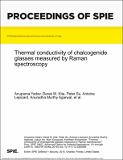Thermal conductivity of chalcogenide glasses measured by Raman spectroscopy
Author(s)
Yadav, Anupama; Kita, Derek; Su, Peter; Agarwal, Anuradha; Hu, Juejun; Dussauze, Marc; Richardson, Kathleen; Lepicard, Antoine; ... Show more Show less
DownloadPublished version (741.2Kb)
Terms of use
Metadata
Show full item recordAbstract
© COPYRIGHT SPIE. Downloading of the abstract is permitted for personal use only. We review the potential and limitations of a temperature-dependent Raman Scattering Technique (RST) as a nondestructive optical tool to investigate the thermal properties of bulk Chalcogenide Glasses (ChGs). Conventional thermal conductivity measurement techniques employed for bulk materials cannot be readily extended to thin films created from the parent bulk. This work summarizes the state of the art, and discusses the possibility to measure more accurately the thermal conductivity of bulk ChGs with micrometer resolution using RST. Using this information, we aim to extend the method to measure the thermal conductivity on thin films. While RST has been employed to evaluate the thermal conductivity data of 2D materials such as graphene, molybdenum disulfide, carbon nanotubes and silicon, it has not been used to effectively duplicate data on ChGs which have been measured by traditional measurement tools. The present work identifies and summarizes the limitations of using RST to measure the thermal conductivity on ChGs. In this technique, the temperature of a laser spot was monitored using Raman Scattering Spectra, and efforts were made to measure the thermal conductivity of bulk AMTIR 1 (Ge 33 As 12 Se 55 ) and Ge 32.5 As 10 Se 57.5 ChGs by analyzing heat diffusion equations. To validate the approach, another conventional technique - Transient Plane Source (TPS) has been used for assessing the thermal conductivity of these bulk glasses. Extension to other more complicated materials (glass ceramics) where signatures from both the glassy matrix and crystallites, are discussed.
Date issued
2018-5-8Department
MIT Materials Research Laboratory; Massachusetts Institute of Technology. Department of Materials Science and EngineeringPublisher
SPIE
ISBN
9781510617650
9781510617667